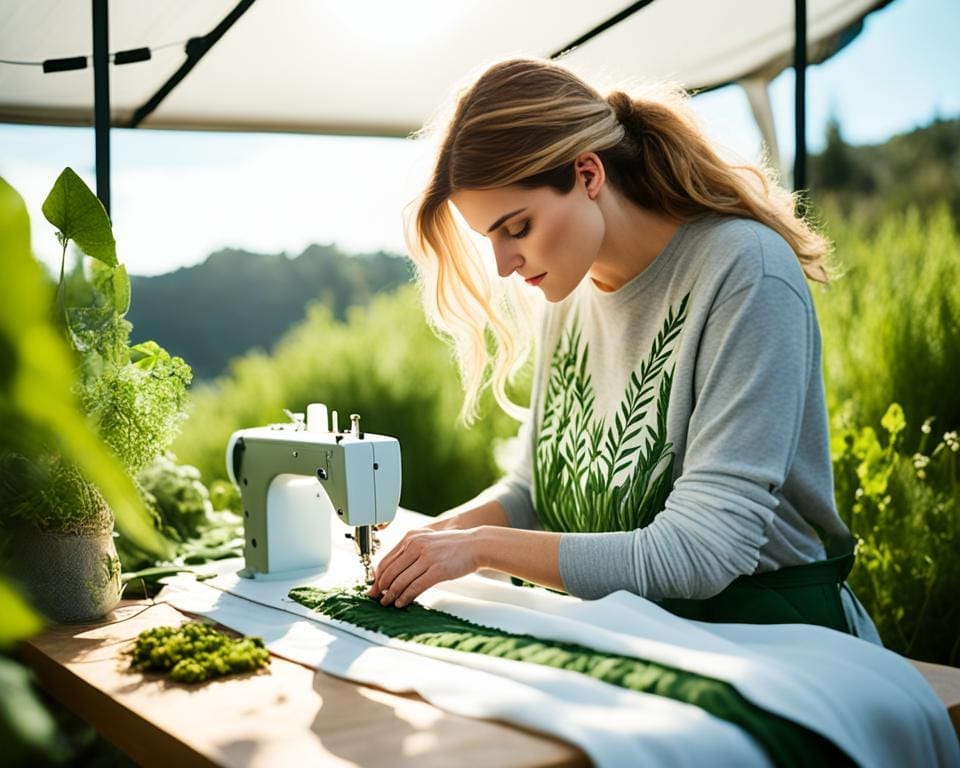The rise of fast fashion has greatly changed fashion’s landscape in the last two decades. It made clothes more available and cheaper, but at a high environmental cost. The industry nearly contributes to 10% of the world’s carbon emissions. This equals Europe’s entire emissions and creates over 92 million tons of waste yearly. This promotes a culture where clothes are seen as disposable.
Then came the slow fashion movement, a sustainable option promoting quality over quantity. Supported by groups like the Centre for Sustainable Fashion and highlighted by Kate Fletcher’s work, it stresses mindful buying and ethical practices. By choosing sustainable fashion, we can lessen our wardrobe’s environmental harm. This change respects both our planet and its people.
The interest in ethical fashion reflects a growing awareness among buyers about their purchases’ environmental impact. Embracing slow fashion values, we advocate for creativity, uniqueness, and accountability. This shifts how we view style today, paving the way for a more responsible fashion future.
Understanding Slow Fashion and Its Importance
The fashion industry is changing because people are now aware of fast fashion’s problems. They see how it harms our planet and people, especially in producing clothes quickly. The UN talks about how this issue affects our climate, pollutes, and hurts animal life. A huge majority of workers in this sector are women of colour, facing unfair treatment and inequality.
The Evolution from Fast Fashion to Slow Fashion
The slow fashion movement is about making kinder choices for everyone and Earth. Influencers who once pushed fast fashion are switching to ethical outfits. Groups like Fashion Revolution are making people demand better from brands.
They encourage us to buy less but better quality. This helps cut down waste and supports a circular economy. This means we aim to use clothes for longer, reducing waste.
The Core Principles of Slow Fashion
Slow fashion focuses on quality, lasting design, and fairness for workers. These brands make fewer items but care more about their impact. They follow key steps:
- Using sustainable materials and natural fibres.
- Choosing production that is fair to workers.
- Supporting second-hand shopping and donating clothes to lessen waste.
- Opting for classic looks over quick trends to decrease buying.
By choosing clothes that last and mean more to us, consumers promote less environmental harm. Slow fashion links style to caring for the planet. It shows that when we shop wisely, we can make the industry more ethical.

Why Slow Fashion Is the Future of the Industry
The fashion industry is changing because people care more about its impact on the planet. Customers now prefer buying clothes that are kind to the earth, leading to a big shift towards responsible buying. This change shows that people value slow fashion. This approach focuses on quality and eco-friendly habits rather than making clothes quickly and cheaply.
The Shift in Consumer Behaviour
Buyers today know how their shopping affects the world. They’re turning away from fast fashion due to its huge waste and impact on climate change—it’s responsible for 8% of the world’s carbon emissions. Nowadays, people choose durable clothes made of organic materials. Initiatives like the Rule of Five and the 30-wear challenge encourage choosing clothes that last and reflect personal values. This change highlights a move towards responsible buying and the acceptance of sustainable fashion.
The Integration of Eco-Friendly Practices
As more people become aware, the fashion industry is adopting greener practices. Brands like Levi’s and Timberland are changing their business models to be more sustainable. They’re using recycled materials and new methods to help create a world where we waste less through renting, thrifting, and repairing. Slow fashion brands make clothes to order, reducing excess and focusing on careful production. This shows their commitment to being ethical and protecting our environment.
The Role of Legislation in Promoting Change
Laws are essential in creating a greener fashion industry. Governments and groups are setting rules to make the industry more open and responsible. The Fashion Act, for example, makes big companies follow ethical production rules. Advocacy led by notable community members pushes for better treatment of workers and eco-friendlier production. This highlights how change is possible in the fashion world.
Benefits of Embracing Slow Fashion
Slow fashion offers many benefits for both buyers and the fashion world. It helps cut down the industry’s carbon footprint. The fashion sector is responsible for up to 10% of world carbon emissions. By choosing sustainable fashion, people support brands that use eco-friendly materials and fair production practices.
More than 30% of shoppers worry about the environmental impact of their purchases. They prefer to buy durable items that reflect their values. This approach supports sustainability and reduces harm to our planet.
Slow fashion focuses on making clothes that last and don’t quickly go out of style. This means less waste. Brands are using new, less wasteful ways to make their clothes, like print-on-demand. Moving away from making huge amounts of clothes at once can make customers more loyal. It also helps the environment by cutting down on harmful emissions and water use.
Choosing slow fashion also means supporting fair work and safe conditions in the industry. It encourages companies to care more about the environment and their workers. This change helps us see clothes as more than just things to buy. They represent important values. Slow fashion is leading towards a more thoughtful and ethical way of thinking, bringing brands and customers closer. It’s paving the way for a future that cares about our planet and its people.









